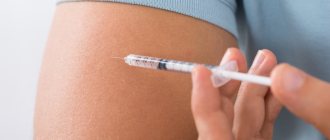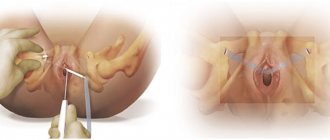What is diabetes?
Diabetes is a disease characterized by a persistent increase in blood sugar levels.
This occurs due to a violation of the absorption of glucose (sugar) by the body's cells. Type I diabetes is caused by autoimmune processes that damage the pancreas. This form of diabetes is quite rare, occurring in approximately 10% of patients. When damaged pancreatic cells are no longer able to produce sufficient amounts of the hormone insulin, pathology develops. Insulin is responsible for the penetration of glucose from the blood into cells, and if this hormone is not enough, glucose remains in the blood, poisoning the body.
Type II diabetes occurs against the background of cell resistance (resistance) to insulin. It develops due to constant surges in blood glucose levels in healthy people. In the early stages of the disease, the pancreas produces an increased amount of insulin, but subsequently patients may need to take insulin from outside. Type II diabetes is often accompanied by obesity and a sedentary lifestyle.
Why diabetes is dangerous
Diabetes mellitus is called a vascular disease, since it primarily affects the blood vessels. The disease affects the aorta, carotid artery, coronary arteries and smaller vessels (retina). And this can lead to serious complications (Table 1).
| Table 1. Main complications of diabetes mellitus. | |
| Complication | Cause of complication |
| Myocardial infarction, stroke, coronary heart disease | In large vessels, atherosclerosis processes develop and atherosclerotic plaques appear, which narrow their lumen (macroangiopathy). As a result, tissue oxygen starvation occurs. If tissues do not receive enough oxygen, the vessels become unable to deliver blood in the required volume to the organs. |
| Renal dysfunction | Beneficial proteins begin to “leave” in the urine, and harmful substances (creatinine or urea), on the contrary, remain in the blood. They poison the body (uremia). The patient experiences swelling and blood pressure rises. |
| Damage to the blood vessels of the eyes | Due to changes in sugar levels or inadequate effects of insulin, the blood vessels in the eyes become injured and dilate. Balls (microaneurysms) appear on the walls of the arteries, which then burst, resulting in hemorrhage. |
| Retinal damage (diabetic retinopathy) | The disease first affects small arteries, and microhemorrhages may occur. Ultimately, new ones begin to sprout in place of old vessels. This leads to severe vision loss or blindness. |
| Diabetic foot (gangrene of the lower extremities) | The vessels and nerve fibers of the lower extremities are affected. The infection penetrates through the skin ulcer, tissue death occurs due to impaired blood flow and infection (gangrene). As a result, limb amputation is possible. |
| Charcot foot | Inflammatory processes occur in the metatarsal bones. The foot can take on the most bizarre shapes. |
| Hypoglycemic coma | There is a sudden drop in blood sugar. The man becomes covered in cold, sticky sweat and his hands begin to tremble. He ceases to understand what he is doing. Appetite increases sharply, you want to eat or drink something. Ultimately, the person may lose consciousness. |
| Ketoacidotic coma | The patient begins to lose weight quickly, drinks a lot of water and goes to the toilet often. The body stops absorbing glucose. The person sharply weakens, loses energy, and becomes inhibited. Fat breakdown occurs in the body. The breakdown products of fats - ketone bodies - are toxic, they poison the body. The patient is dehydrated, doctors note very high blood sugar levels. The patient emits a strong odor of acetone. The patient begins to lose weight quickly, drinks a lot of water and goes to the toilet often. The body stops absorbing glucose. The person sharply weakens, loses energy, and becomes inhibited. |
In addition, diabetes mellitus is often an aggravating factor for other diseases and increases the risk of their complications.
Diabetes mellitus and urine tests
People with diabetes often undergo urine tests to screen for diabetes-related kidney disease and severe hyperglycemia.
Urine tests for diabetic kidney disease
Kidney problems occur in 20-40% of people with diabetes. However, with early and intensive control of blood sugar levels, blood pressure and the use of certain medications, the development and progression of kidney disease can be slowed.
To detect kidney problems, your doctor may do a urine test that measures the amount of protein in your urine, called microalbuminuria. It develops when small amounts of albumin (the main protein in your blood) leak into your urine. Without treatment that reduces protein leakage, kidney damage continues and leads to kidney failure.
This test should be done annually, starting from the time you are diagnosed with type 2 diabetes. This is done because diabetes is usually present for many years before it is diagnosed.
If you have type 1 diabetes, this test is not usually done for the first five years after diagnosis.
What happens if the test for microalbuminuria is positive?
If the test for microalbuminuria is positive, this indicates that the blood vessels in your kidneys are damaged. It also reflects more common blood vessel diseases, which may increase your risk of developing heart problems. Therefore, your doctor may take the following steps:
- Prescribe medications to slow down the process of kidney damage. Your doctor may recommend starting specific medications to prevent further damage to your blood vessels and kidneys. If your microalbuminuria levels are high, your doctor may order another type of urine test, which involves collecting your urine for 24 hours to more accurately determine the amount of damage to your kidneys and how well they are working.
- Offer more aggressive treatment for diabetes. Because studies have shown that closely controlling your blood sugar levels significantly reduces kidney damage, your doctor may recommend more aggressive treatment for your diabetes.
- Better blood pressure control. Controlling blood pressure has also been shown to reduce the risk of kidney damage in diabetes. It is necessary to measure your blood pressure at every visit to the doctor. The recommended target blood pressure for people with diabetes is 130/80 mmHg. Art. and below.
- Better cholesterol control. Because microalbuminuria suggests you have an increased risk of developing heart disease, your doctor may try to return your cholesterol and other fats to healthy levels.
Urine tests for severe hyperglycemia
Sometimes your doctor may do a urine test to determine if your blood sugar levels are dangerously high and if you have started producing substances called ketone bodies. They are byproducts that are formed during the fat burning process that occurs in the absence of insulin. When a person with diabetes develops hyperglycemia, or high blood sugar when there is not enough insulin (type 1 diabetes), or if the body cannot use it properly (type 2 diabetes) and the breakdown of sugars occurs, the body begins to use fat stores in as a source of energy for body cells. Although ketones can be a source of energy for many cells, in large quantities they can be toxic and cause a life-threatening emergency condition called ketoacidosis.
The level of ketone bodies (acetone) in your urine can be measured by your doctor or at home using special test strips sold over-the-counter.
How to analyze the level of ketone bodies?
The ketone body test involves dipping a test strip into your urine. In this case, the strip should change color and then it must be compared with the color scale.
When should I test my ketone levels?
If you have type 1 diabetes, check your urine for the presence of acetone if:
- You feel sick (a cold, the flu, or some other illness), nausea or vomiting.
- You are pregnant.
- You have high blood sugar (usually above 240 milligrams per deciliter (mg/dL), or 13.3 mmol/hemoglobin), or when your doctor orders it.
If you have type 2 diabetes, you are less likely to develop ketoacidosis, even if you are receiving insulin therapy. However, in severe illnesses it can develop.
If you have type 2 diabetes, you should check the level of ketone bodies in your urine if:
- Feel very sick (cold, flu or other illness) and/or have unexplained nausea or vomiting
- Your blood sugar level is high (over 300 milligrams per deciliter (mg/dL) or 16.6 mmol/L (or as directed by your doctor) and continues to rise throughout the day.
When should I call my doctor?
A urine test for ketone bodies should always be negative. You should report any positive results to your doctor immediately. You should also call your doctor right away if your blood sugar remains high or if you have stomach pain, nausea, vomiting, fast breathing, a sweet smell on your breath, or urinate too often.
After you contact your doctor, you should:
- Drink enough water or other fluid to try to reduce ketone levels and keep your body hydrated.
- Continue to periodically check your blood sugar levels; it may be high and you may need to give yourself a small amount of rapid-acting insulin, which takes effect very quickly. Your doctor will instruct you on what to do.
- Go to your local emergency room if your doctor has given you IV fluids and insulin therapy.
How should I record the results of my urine tests?
Keep careful records of any urine test or acetone test you perform. Your notes can help you and your doctor identify any problems. Take these notes with you every time you visit your doctor.
- Get information about how to manage diabetes every day.
- Learn about glycosylated hemoglobin A1C, an important blood test for people with diabetes.
- View the full table of contents of the Diabetes Guide.
Diabetes symptoms
Common initial symptoms of diabetes (Fig. 1) include:
- dry mouth, constant thirst. A person consumes a lot of fluid, so he experiences frequent urge to go to the toilet;
- strong feeling of hunger;
- causeless weight loss or, conversely, sudden weight gain, development of obesity;
- poor wound healing. As a result, pustules and ulcers appear;
- More rare cases include memory loss and headaches.
Figure 1. Some common symptoms of diabetes.
Source: medindia.net But since the disease has several types (sugar, gestational, non-sugar), it proceeds in different ways. In some cases, the patient is not even aware of the presence of diabetes and the diagnosis is made by chance: during a clinical examination or hospitalization for a completely different disease.
Symptoms of type I diabetes
Type I diabetes mellitus occurs at a young age, but can also be congenital. In this case, the pancreas either does not produce insulin at all or produces insufficient amounts. The only treatment is insulin injections. It’s not for nothing that this type of disease is called insulin-dependent diabetes.
Important! If a person with diabetes does not eat on time, injects himself with too much insulin, or overdoes physical training, his blood glucose concentration may sharply decrease - hypoglycemia will occur. This is a life-threatening condition whose symptoms can be frightening. Hypoglycemia can result in loss of consciousness, seizures and coma. All patients with diabetes, their friends and relatives should know and recognize the first signs of hypoglycemia, including:
- weakness,
- loss of orientation,
- blurred vision,
- increased sweating,
- headache,
- strong feeling of hunger.
Symptoms of type II diabetes mellitus
This type is called insulin-independent. After all, the pancreas produces insulin, but the body develops resistance to it (insulin resistance). In the early stages of the disease, glucose-lowering drugs are usually sufficient to treat type II diabetes.
According to doctors, this type of diabetes has become “younger.” The disease usually occurred in people over 40 years of age, but now teenagers also suffer from type II diabetes.
This type may have no symptoms. Among the most common:
- change in body weight: a person suddenly loses weight or, conversely, gains it. Obesity is not a symptom of diabetes, but can lead to it;
- scratches that take a long time to heal and fester. As a result, ulcers occur (mainly on the feet);
- memory loss due to constant fluctuations in blood sugar.
Symptoms such as thirst, dry mouth, and frequent urination are much less characteristic of the disease and only with very high blood sugar levels.
Symptoms of Gestational Diabetes
Gestational diabetes (or pregnancy diabetes) is diabetes that occurs during pregnancy and goes away immediately after it.
Every pregnant woman develops insulin resistance, which can lead to pathology. Diabetes may go away after childbirth or remain, especially in women who are obese or have a genetic predisposition to the disease. In a number of cases, women had type II diabetes before pregnancy, but the disease did not manifest itself in any way.
Every pregnant woman, after registering at the antenatal clinic, is screened for gestational diabetes. For control, the doctor takes a blood test for sugar and the level of glycated hemoglobin, and then, at 24-28 weeks of pregnancy, a glucose tolerance test. Three days after birth, women diagnosed with gestational diabetes undergo a control test. If the blood sugar level has returned to normal, the diagnosis is removed; if it is not normal, further observation is necessary.
Symptoms of diabetes insipidus
The main cause of diabetes insipidus is the lack of production of a certain pituitary hormone (antidiuretic hormone). This is the hormone that affects water-salt metabolism.
The main symptom is the consumption of large amounts of fluid and frequent urge to go to the toilet. The patient can drink 15–20 liters of fluid per day and excrete the same amount. The patient's health is normal and there are no other complaints. The patient's sugar level is normal, but the specific gravity of the urine is low. In other words, a person pees with water.
Causes and symptoms of sugar in urine
One of the natural reasons for a short-term increase in glucose levels is isolated cases of increased consumption of foods rich in carbohydrates. This is the so-called nutritional glycosuria. Glucose levels also increase due to stress and emotional instability. Glucose in urine
sometimes increases in pregnant women, which requires observation and consultation with a specialist.
The main symptoms of an increase in the amount of glucose in the urine are:
- a constant feeling of thirst;
- permanent drowsiness and fatigue;
- unpleasant irritating sensations in the genital area;
- polyuria (increased urge to urinate);
- dehydration of the skin;
- sudden weight loss.
Based on the fact that the mechanism of development of glucosuria starts very easily and unnoticed by a person, if you discover one or more of the above symptoms or signs, you should immediately consult a doctor.
You can make an appointment with an endocrinologist from our consultants by calling +7 (495) 125-49-50
Prices for endocrinologist services Addresses of clinics Ultrasound of the thyroid gland Protein in urine Consultation with an endocrinologist Calling an endocrinologist to your home










